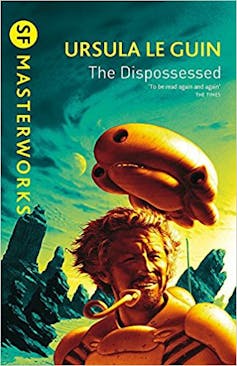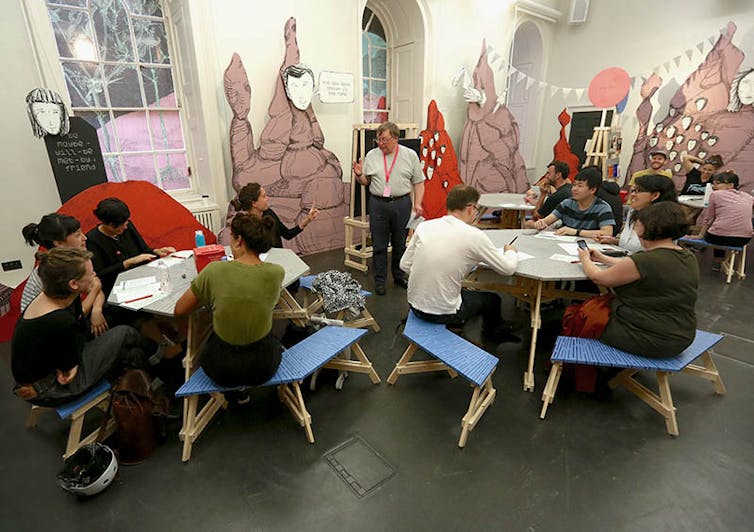The many articles written in memory of Ursula le Guin, who left this world on her final voyage last month, are testament to the great power of her storytelling. Le Guin’s tales give us insights into different ways of being human, from the deceptively mundane (the Orsinian Tales) through the remote but plausible (the Hainish Cycle of science fiction novels), and into the enchantingly fantastic (the Earthsea stories). Her stories help us to understand others and ourselves. They demonstrate the great power that language has in creating imagined worlds.
This is perhaps most obvious in her 1974 award-winning novel, The Dispossessed. The book has been in press since 1974, and has been translated into at least 30 languages. The novel tells the story of a scientist, Shevek, and his battle against the bureaucracies of two planets to ensure his invention will benefit all humans. The invention is an instantaneous communication device which overcomes the limitation of light speed communication; but the device is just an artefact of the narrative. The real story is about people, their cultures, and how they build these – through language.

The Dispossessed is set on two human worlds: the planet Urras, which resembles 1970s Earth; and Anarres, the moon of Urras, home to a unified anarchist collective. Anarres was settled from Urras by people seeking a better, fairer life, and the resulting collective has been largely isolated from Urran cultures for about 150 years.
Anarres is a planet without property, laws or money; but it does have an advisory bureaucracy and some shared conventions, one of which is the language Pravic. This language was devised by the first settlers, to make the everyday casual ownership which pervades human languages almost impossible to articulate.
Anarres is, of course, a utopia; so it slotted well into Utopia 2016, an exhibition at Somerset House for the 500th anniversary of the publication of Thomas More’s Utopia. The event showcased a series of utopian visions presented by a range of artists. Two of these artists, Onkar Kular and Noam Toran, proposed that the utopia of Anarres could be presented as a teaching space which they called Night School on Anarres. The teaching space was designed to showcase the planet and its culture, offering the people of Earth a window into a working anarchistic society.
But the night school was also intended to offer realistic lessons in Pravic, so the project needed a realistic language to teach. This was not going to be easy. Le Guin had described some key features of the language in her book but, apart from a few names, she provided no close detail of how the language worked.
This is where I came in. I teach a module on the BA English Language and Linguistics course at King’s College London in which the students design and describe their own constructed language, or “conlang”. The module is an opportunity for students to show their knowledge of how language works (or could work) in the abstract, but it also gives them a chance to be creative in their reasoning.
Kular and Toran asked me to generate a version of Pravic for the project. It had to be as close as possible to the language described in the book; it had to be easy enough to teach the basics in one hour; and it had to feel like a real human language.
The final design incorporated almost everything le Guin stipulated about Pravic in the book. The designed language makes it difficult to assert ownership: possessive pronouns (“my”, “your”, “their”, etc.) are out, but simple words like “have” and “give” must also be excised.
Expression of self also has to be restricted: people would not “do” things (this creates ownership of the action), things “are done” by people. Consequently, the whole language is expressed in the passive voice.
Another device to reduce selfhood was taken from Malay: the pronouns “I” and “you” were replaced by noun phrases expressing roles, with default roles being “a speaker” and “the listener(s)”. A version of this was used by the Faceless Men in Game of Thrones.

In the end, though, an anglicised version of Pravic, Pravlish, was used for the lessons. After being shown a video travelogue and introduced to some simple Pravic conventions (no pronouns, no ownership, the actor in an action is given last, and “People don’t do things, things happen to people”), the students were asked to translate some difficult sentences into Pravlish – for instance, Julius Caesar’s “I came, I saw, I conquered” and Louis XIV’s “It is legal because I wish it”. The solutions offered were ingenious and entertaining.
In The Dispossessed, Ursula le Guin gave us an honest look at how anarchism might work in a real world with real human beings. I like to think that the Night School project did the same for a new audience. Linguistically, the project showed that language is not just a coding tool we use to give and get meaning; rather, it has an active role in producing these meanings. And so the conventions we build into our language affect what meanings are possible.

